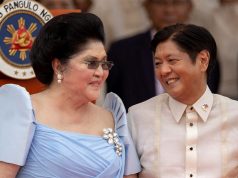
“On Wednesday, we wear black.”
Student bodies are inviting everyone to wear black in observance of the 50th anniversary of the Martial Law declaration, a period that lasted for almost a decade.
Rep. Raoul Manuel (Kabataan party-list) compiled some of the student councils and organizations calling on their fellow youth to mark the historical period by remembering those who sacrificed their lives and freedom.
Ateneo Law Student Council
“As we mourn the atrocities of the past and the disinformation and historical revisionism that continues to plague our country, we express our protest and solidarity against the Marcos regimes, past and present,” the Ateneo Law Student Council, one of the student bodies, said on Facebook.
“We remember the dark history of our country’s Martial Law years and those who sacrificed their lives and freedoms so that we may enjoy them today. As we do, we ourselves commit to the fight of our generation — for genuine democracy, for freedom, and for the Filipino people,” it added.
DLSU University Student Government
La Salle College Antipolo Student Council
FEU Central Student Organization
UP Diliman University Student Council
Adamson University Student Government
National University Student Government
Siliman University Student Government
Mindanao State University – General Santos City’s Political Science Students’ Organization
In protests, the color black symbolizes resistance.
According to Erin Vearncombe, research specialist from the University of Toronto, black clothing “remains a hugely significant form of oppositional dress.”
She said that it “signals everything from independent thought to outright defiance and revolution.”
Martial Law
Late dictator Ferdinand Marcos Sr. placed the country under martial rule from Sept. 21, 1972 to Jan. 17, 1981 to supposedly quell the communist insurgency and restore order.
Critics, however, believe it was his way to extend his term since at that time, his second term as president was about to end.
The nine-year period saw curfews being imposed, public assemblies being forbidden and the suspension of the writ of habeas corpus, a legal remedy that protects citizens from unlawful arrests and indefinite detentions.
Martial Law also saw the curtailment of civil rights and liberties, prevalence of extrajudicial killings and unsolved disappearances, media suppression and economic recession, among others.
It was also during this period when the word “salvage,” which originally means to save, became part of the local language to denote extralegal killings.
London-based human rights organization Amnesty Organization said that “some 70,000 people were imprisoned and 34,000 were tortured; over 3,200 people were killed” in its imposition.
RELATED: 31 YEARS OF AMNESIA: STORIES ON THE MYTHS THAT MADE MARCOS









